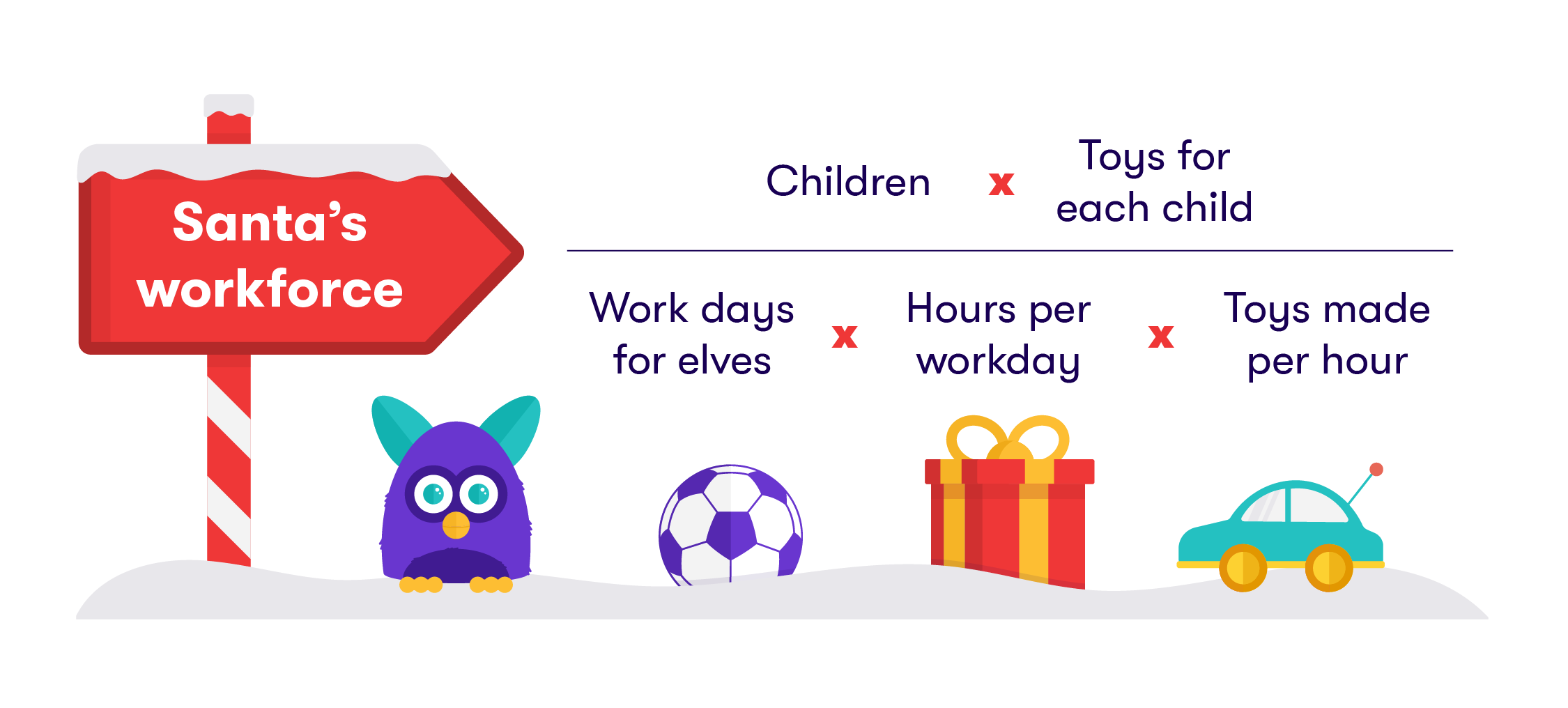Dec 24, 2018
It’s The Most Profitable Time of the Year: Inside Santa’s Workshop
Imagine Santa Claus Inc.’s financial disclosure. This is what it would look like.

What if Santa Claus’ North Pole-based operation was an actual business or non-profit organization?
He’d be faced some unique challenges, to say the least, including maintaining a large, elvish workforce, building out huge factories and storage facilities, and of course, dealing with the health consequences of eating millions of cookies.
As a fun little exercise, we attempted to calculate out some of the business costs Santa faces, as well as how big of a market the big man is trying to serve.
Tighten your sash, we’re about to slide down a strange chimney.
Santa’s market
There are more than 525 million children under the age of 14 who are likely to celebrate Christmas in the world. We can use this as our bare-bones estimate—there are likely tens or hundreds of millions more.
So, we’ll say that Santa has to visit at least 525 million kids on Christmas night. And if we say that Santa gives each kid three presents, we know that he’ll need at least 1.575 billion gifts ready for delivery.
How he does it remains a mystery, so we’ll give him the benefit of the doubt that he can get it done. We just need to know the size of the market.
Santa’s workforce
If you need at least 1.5 billion toys ready for delivery every Christmas, it’s going to require a lot of labor. But just how much?
To calculate how much elf-power would be needed to produce the appropriate number of toys, we could use an equation such as this:

So, what if we have 525 million kids, and each needs three toys, elves work 364 days per year for 8 hours, creating four toys per hour? By plugging in these variables into the equation, we find that Santa’s elf workforce would total up to 135,216.
As for what these elves are being paid? The North Pole is actually outside of any nation’s exclusive economic zone—an area stretching out from a country’s shoreline in which that country’s laws and regulations would apply—so there wouldn’t be any specific regulations related to wages that would apply. In other words, there are no rules Santa would have to abide by.
But, for fun, if you wanted to apply the U.S. federal minimum wage of $7.25 per hour, your average worker elf would earn a measly $21,112 per year working 8 hours per day, 364 days per year.
Equipment and facilities
Here are some quick estimates for some of the other costs Santa should expect to encounter:
- Reindeer: $1,000 each, plus $2,000 annual upkeep.
- Sleigh: $5,500, plus insurance.
- The suit, plus dry cleaning: ~$500.
- Health costs (too many cookies): ~$16,000 per year.
As for factory and warehouse space, the costs could vary. We can presume that Santa already owns plenty of North Pole acreage, so his costs likely revolve around construction and heating.
We don’t know how much space Santa would need—but we could possibly compare it to perhaps a similar commercial complex, Amazon’s recently announced global hub in Cincinnati. That hub will have more than 3 million square feet in which to conduct operations, and have a footprint of 1,100 acres.
The total cost is expected to be $1.5 billion. Santa may end up paying more for a similar facility, since transporting materials to the North Pole is likely to present logistical challenges.
Taxes
The North Pole is a wild, lawless land. As such, there wouldn’t be any taxes to pay—because there isn’t a government to pay them to (although, interestingly enough, if you are a Santa Claus actor in Belarus, you’re expected to pony up).
But, again, if Santa wouldn’t want to end up on the IRS’ naughty list. It’s difficult, if not impossible to tell what types of taxes Santa would owe to the IRS, but we do know that he’d likely be able to reduce it considerably—perhaps as much as 50%—due to charitable contribution deductions.
The bottom line
Santa’s not running a cheap outfit up north. He’s giving away billions of dollars in gifts every year, employing tens of thousands, and is faced with some weighty infrastructure and upkeep costs.
All told, he’s running an operation that costs billions of dollars. But that may be a small cost to eat in exchange for tens of millions of happy kids on Christmas morning.
Receive more fun stories, direct to your inbox, by subscribing to the Stash newsletter.
Stash Learn Weekly
Enjoy what you’re reading?
[contact-form-7 id="210" title="Subscribe" html_id="default"]Related Articles

15 Largest AI Companies in 2024

The 12 Largest Cannabis Companies in 2024

What Is a Traditional IRA?

Saving vs. Investing: 2 Ways to Reach Your Financial Goals

How To Invest in the S&P 500: A Beginner’s Guide for 2024

Stock Market Holidays 2024





